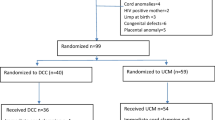Abstract
Purpose
One of the major problems in international literature is how to measure postpartum blood loss with accuracy. We aimed in this research to assess the accuracy of visual estimation of postpartum blood loss (by each of two main health-care providers) compared with the gravimetric calculation method.
Methods
We carried out a prospective cohort study at King Abdulaziz Medical City, Riyadh, Saudi Arabia between 1 November 2009 and 31 December 2009. All women who were admitted to labor and delivery suite and delivered vaginally were included in the study. Postpartum blood loss was visually estimated by the attending physician and obstetrics nurse and then objectively calculated by a gravimetric machine. Comparison between the three methods of blood loss calculation was carried out.
Results
A total of 150 patients were included in this study. There was a significant difference between the gravimetric calculated blood loss and both health-care providers’ estimation with a tendency to underestimate the loss by about 30%. The background and seniority of the assessing health-care provider did not affect the accuracy of the estimation. The corrected incidence of postpartum hemorrhage in Saudi Arabia was found to be 1.47%.
Conclusion
Health-care providers tend to underestimate the volume of postpartum blood loss by about 30%. Training and continuous auditing of the diagnosis of postpartum hemorrhage is needed to avoid missing cases and thus preventing associated morbidity and mortality.
Similar content being viewed by others
References
World Health Organization: The World Report 2005. Attending to 136 million births, every year 2005. Make every mother and child count (2005) In: Geneva: the World Health Organization, pp 62–63
Tourne G, Collet F, Lasnier P, Seffert P (2004) Usefulness of a collecting bag for the diagnosis of post-partum hemorrhage. J Gynecol Obstet Biol Reprod (Paris) 33(3):229–234
Chua S, Ho LM, Vanaja K, Nordstrom L, Roy AC, Arulkumaran S (1998) Validation of a laboratory method of measuring postpartum blood loss. Gynecol Obstet Invest 46:31–33
Patel A, Goudar SS, Geller SE, Kodakany BS, Edlavitch SA, Wagh K, Patted SS, Naik VA, Moss N, Derman RJ (2006) Drape estimation vs. visual assessment for estimating postpartum hemorrhage. Int J Gynaecol Obstet 93(3):220–224
Bose P, Regan F, Paterson-Brown S (2006) Improving the accuracy of estimated blood loss at obstetric haemorrhage using clinical reconstructions. BJOG 113(8):919–924
Razvi K, Chua S, Arulkumaran S, Ratnam SS (1996) A comparison between visual estimation and laboratory determination of blood loss during the 3rd stage of labour. Aust NZ J Obstet Gynaecol 36(2):152–154
Meiser A, Casagranda O, Skipka G, Laubenthal H (2001) Quantification of blood loss. How precise is visual estimation and what does its accuracy depend on? Anaesthesist 50(1):13–20
Newton M, Mosey LM, Egli GE, Gifford WB, Hull CT (1961) Blood loss during and immediately after delivery. Obstet Gynecol 17:9–18
Dildy GA, Paine AR, George NC, Velasco C (2004) Estimating blood loss: can teaching significantly improve visual estimation? Obstet Gynecol 104(3):601–606
Patton K, Funk DL, McErlean M, Bartfield JM (2001) Accuracy of estimation of external blood loss by EMS personnel. J Trauma 50(5):914–916
Lee MH, Ingvertsen BT, Kirpensteijn J, Jensen AL, Kristensen AT (2006) Quantification of surgical blood loss. Vet Surg 35(4):388–393
Lain SJ, Roberts CL, Hadfield RM, Bell JC, Morris JM (2008) How accurate is the reporting of obstetric haemorrhage in hospital discharge data? A validation study. Aust N Z J Obstet Gynaecol 48(5):481–484
Al-Kadri HM, Tariq S, Tamim HM (2009) Risk factors for postpartum hemorrhage among Saudi women. Saudi Med J 30(10):1305–1310
Larsson C, Saltvedt S, Wiklund I, Pahlen S, Andolf E (2006) Estimation of blood loss after cesarean section and vaginal delivery has low validity with a tendency to exaggeration. Acta Obstet Gynecol Scand 85(12):1448–1452
Yoong W, Karavolos S, Damodaram M, Madgwick K, Milestone N, Al-Habib A, Fakokunde A, Okolo S (2009) Observer accuracy and reproducibility of visual estimation of blood loss in obstetrics: how accurate and consistent are health-care professionals? Arch Gynecol Obstet 281(2):207–213
Tebruegge M, Misra I, Pantazidou A, Padhye A, Maity S, Dwarakanathan B, Donath S, Curtis N, Nerminathan V (2009) Estimating blood loss: comparative study of the accuracy of parents and health care professionals. Pediatrics 124(4):e729–e736
Wandabwa J, Doyle P, Todd J, Ononge S, Kiondo P (2008) Risk factors for severe postpartum haemorrhage in Mulago Hospital, Kampala, Uganda. East Afr Med J 85(2):64–71
Cameron CA, Roberts CL, Bell J, Fischer W (2007) Getting an evidence-based post-partum haemorrhage policy into practice. Aust N Z J Obstet Gynaecol 47(3):169–175
Gulmezoglu AM (2004) Postpartum haemorrhage (1997–2002). Monitoring and evaluation department of reproductive health and research. In: WHO, Geneva, 25–26 May 2004
Benedetti T (2002) Obstetric haemorrhage. In: Gabbe SG, Niebyl JR, Simpson JL (eds) A pocket companion to obstetrics, 4th edn. Churchill Livingstone, New York
Maslovitz S, Barkai G, Lessing JB, Ziv A, Many A (2008) Improved accuracy of postpartum blood loss estimation as assessed by simulation. Acta Obstet Gynecol Scand 87(9):929–934
Glover P (2003) Blood loss at delivery: how accurate is your estimation? Aust J Midwifery 16(2):21–24
Buckland SS, Homer CS (2007) Estimating blood loss after birth: using simulated clinical examples. Women Birth 20(2):85–88
Sukprasert M, Choktanasiri W, Ayudhya NI, Promsonthi P, O-Prasertsawat P (2006) Increase accuracy of visual estimation of blood loss from education programme. J Med Assoc Thail 89(Suppl 4):S54–S59
Pavelka R, Linkesch W, Kofler E (1981) Hematologic parameters and iron state in the perinatal period. Arch Gynecol 230(4):275–281
Grathwohl KW, Bruns BJ, LeBrun CJ, Ohno AK, Dillard TA, Cushner HM (1996) Does hemodilution exist? Effects of saline infusion on hematologic parameters in euvolemic subjects. South Med J 89(1):51–55
Conflict of interest statement
The authors declare no conflict of interest.
Author information
Authors and Affiliations
Corresponding author
Rights and permissions
About this article
Cite this article
Al Kadri, H.M.F., Al Anazi, B.K. & Tamim, H.M. Visual estimation versus gravimetric measurement of postpartum blood loss: a prospective cohort study. Arch Gynecol Obstet 283, 1207–1213 (2011). https://doi.org/10.1007/s00404-010-1522-1
Received:
Accepted:
Published:
Issue Date:
DOI: https://doi.org/10.1007/s00404-010-1522-1




